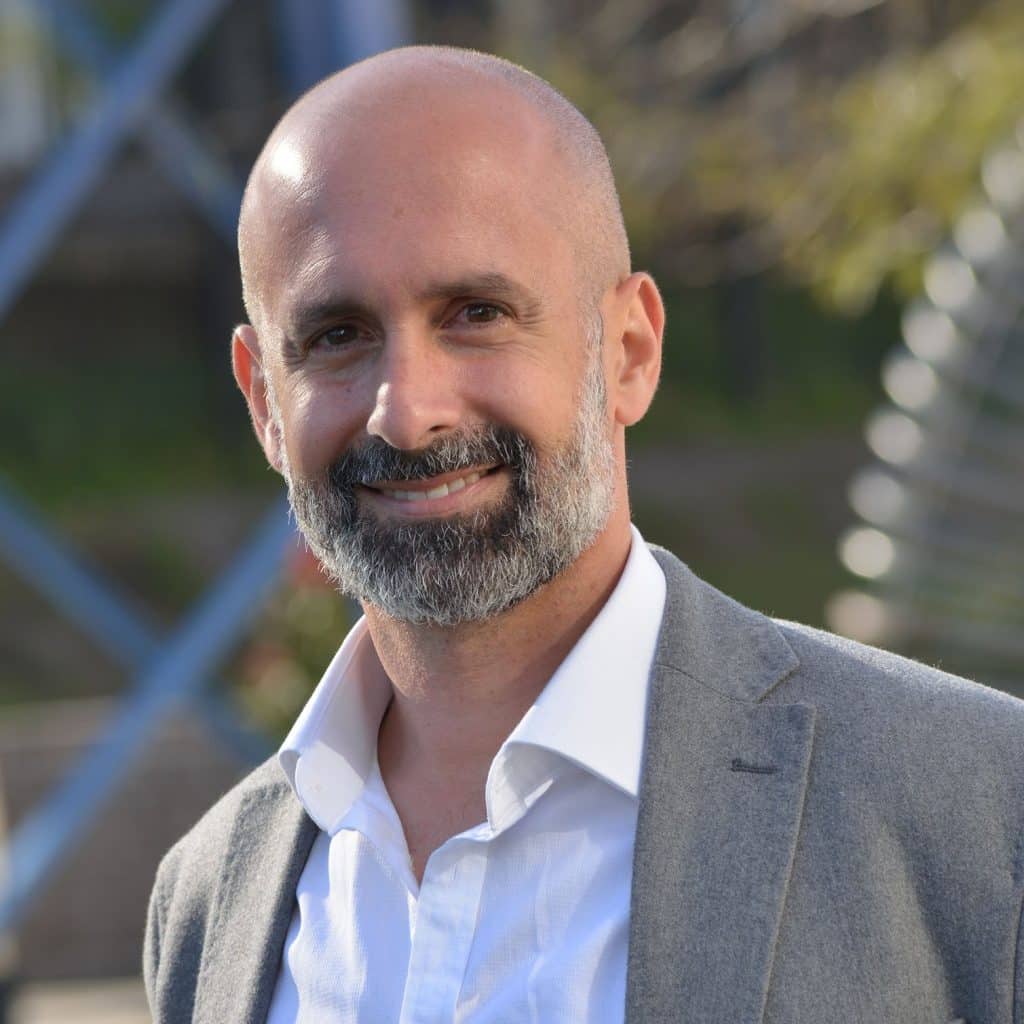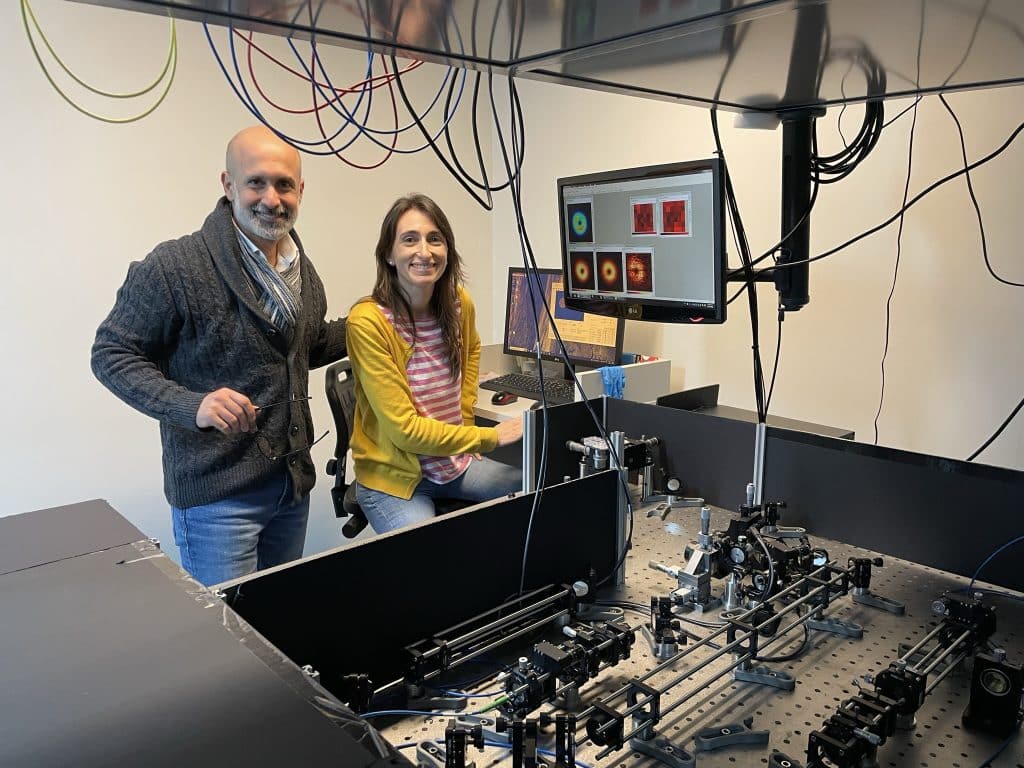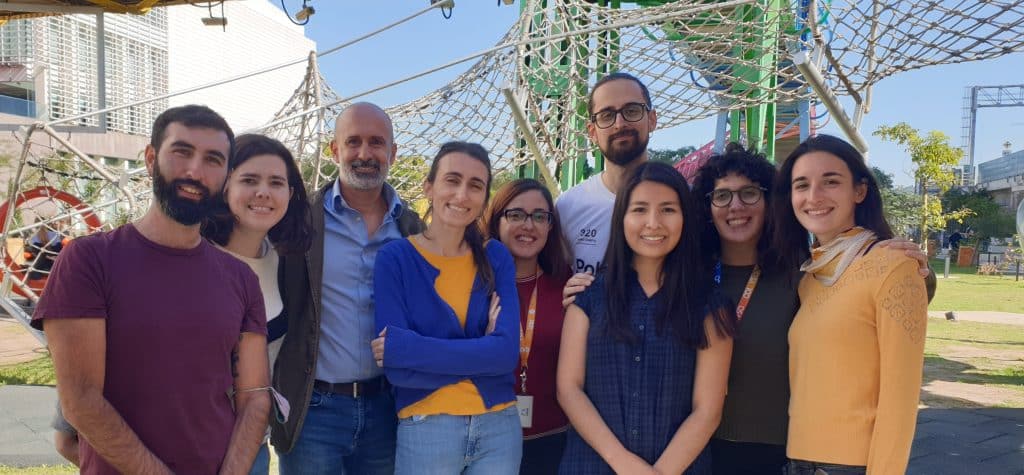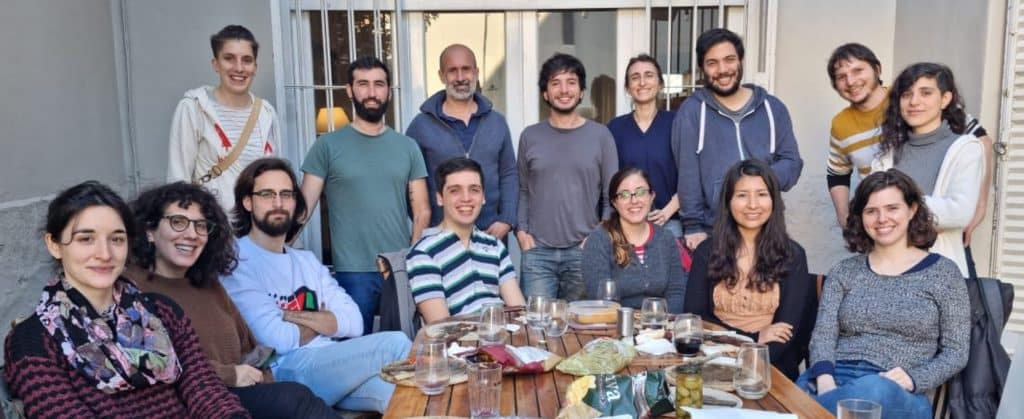An interview with Fernando Stefani
Posted by Mariana De Niz, on 1 November 2022

MiniBio:
Born and raised in Buenos Aires, after graduating with honours in Materials Engineering (2001), Fernando Stefani obtained a summa cum laude Ph.D. in Chemistry (2004, Mainz, Germany), for which he obtained the Otto Hahn Medal of the Max-Planck-Society. After a postdoctoral stay at the Institute of Photonics Sciences in Barcelona, and a period as Assistant Professor at the Faculty of Physics of the Ludwig-Maximilians University of Munich, he returned to Buenos Aires (2009) to take positions as Professor of Experimental Physics at the University of Buenos Aires and scientific member of the National Scientific and Technical Research Council (CONICET). During his career, he was mentored by excellent scientists such as Wolfgang Knoll, Niek van Hulst, Jochen Feldmann, Theo Lasser, and Stefan W. Hell, among others. Since his return to Buenos Aires, Prof. Stefani has established an internationally competitive lab that is a regional reference in nanophotonics and super-resolution microscopy, where more than 20 young researchers have had the chance to start their own careers in research or high-tech companies.
Among other distinctions, Prof. Stefani has received the Young Investigator Award in Physics from the National Academy of Exact, Physical and Natural Sciences (2014, Argentina), the Goerg Foster Research Award from the Alexander von Humboldt Foundation (2017, Germany), and the Houssay Prize in Mathematics, Physics, Astronomy, and Computation (2018, Argentina). His articles have been published in prestigious scientific journals such as Nature, Science, ACS Nano, Nature Communications, Nano Letters, and Physical Review Letters. Prof. Stefani has also served as advisor to several institutions and journals, and to the Science and Technology Commissions of the National Congress of Argentina. He is married to Laura and has four sons, Vicente, Mateo, Camilo, and Felipe. His hobbies include sports (running, baseball, softball, football), construction works, writing, and cooking.
What inspired you to become a scientist?
The answer is not what, but who. I was inspired by other scientists whom I had the chance to meet and interact with. My professional life has been determined by two features of my personality: i) a strong curiosity to understand nature in depth and discover new phenomena, and ii) a powerful drive to build things, devices, processes with the highest quality or precision possible. In my youth, it was not clear at all that I would become a scientist. In fact, I had no idea what it meant or how it was to be scientist. There was no scientist around in my family or circle of friends. So, even though I was mainly interested in Chemistry and Physics, I decided to study Engineering. After 2 years of Chemical Engineering studies, when I had passed all the fundamental Chemistry courses, I realized that the remaining courses, more focused on Engineering aspects, were not so appealing to me. Looking for alternatives, I found that Materials Engineering was a better fit: it was still a kind of Engineering, but I could learn quite some more Physics, particularly solid-state Physics. I was lucky, all my teachers of Materials Engineering at the Instituto de Tecnología Jorge Sabato were active researchers in their fields. That was my first introduction to the world of the scientific research, and I found it fascinating. José Galvele and Andrés Kreiner were two of my teachers who first passed me the passion for science. For my graduation, I could choose between doing an internship in a company or in a research lab. The decision was easy, I wanted to do research. So I started looking for options in Argentina and abroad. My interests were so broad and there were so many options… In Argentina I had inspiring conversations with Ernesto Calvo and Oscar Martinez, among other top-level researchers. Finally, I went to the Max-Planck Institute for Polymer Research in Mainz (Germany) to work on detection of DNA hybridization reactions using techniques based on surface-plasmon resonances. My director there was Wolfgang Knoll, a brilliant scientist whom I consider my main mentor. Scientist share the scientific method, but there are many different styles to approach the research work, the organization of teams, the sharing or not of knowledge, the mentoring of young researchers, etc. Wolfgang Knoll shaped my style for good. I can say that he is the one who inspired me to become a scientist as I am today. Then, over the next years I was extremely fortunate to work with several other brilliant scientists, whom I also consider my mentors: Niek van Hulst, Jochen Feldmann, Theo Lasser, and Stefan W. Hell.
You have a career-long involvement in microscopy. Can you tell us a bit about what inspired you to choose this path?
It was not a straight path… At first, when I was interested in detecting molecular transitions and reactions using optical methods. That lead me to get involved in fluorescence. During my Ph.D., I was amazed by the possibility of detecting single molecules using fluorescence and that is when I started working on developing devices and methods to see single-molecules and performing spectroscopy measurements on them. During my postdoc, I continued working on single molecule fluorescence, in this case addressing transitions with ultrafast methods and modulating their emission using optical nanoantennas. Single-molecule nanophotonics was a perfect match for me, as it combined two of my main interests: single-molecule spectroscopy and solid-state physics, particularly of nanostructures metals. From then on my research developed in these two fields. Still today I love to design and perform experiments with single molecules and nanophotonic devices, a topic a carry out in collaboration with my friends and colleagues Philip Tinnefeld and Guillermo Acuna, using new technologies like DNA origami. After 9 years in Europe, I decided to return to Argentina. It was 2010. I had to re think my research directions to find topics suited to the Argentina community and possibilities. To me, and many others, it was clear that super-resolution fluorescence microscopy was the future of biological imaging, and in Argentina there was a strong research community of cellular biology and biomedicine. So my plan was to use my knowledge to introduce and develop super-resolution microscopy in Argentina. I contacted Stefan Hell, who supported me to obtain a Max-Planck Partner Group grant, and that is how it all started…

Can you tell us a bit about what you have found uniquely positive about becoming a researcher in Argentina, from your education years?
I was lucky to receive excellent education in my secondary school and at the University. For secondary school I went to the Instituto Tecnológico Philips Argentina, a technical school specialized on electromechanics. This was a particular school. When I started, it belonged to the company Philips. It was run under a special program of the government to promote so-called factory schools. It was a private school but at not cost to the students. There was a strict admission test, and the students admitted were granted with the tuition fees and received all necessary gear, textbooks and materials for their education. Halfway my studies, that government program stopped working and many of those factory schools closed down. In the case of my school, it continued as a private school but the conditions were maintained for the students that started under the original regime. At University, I first studied at the Universidad Tecnológica Nacional, which is well organized for people who must work in parallel to the studies, as it was my case. Then, I learned about the Instituto de Tecnología Sabato, of the Universidad de San Martín. That institute was located inside a facility of the Comisión Nacional de Energía Atómica, all teachers were active researchers, and you could only study there after a hard admission test and with full dedication. You received a fellowship for that. From my current perspective and having worked in different Universities of Argentina and Europe, I can say that my education was excellent.
Once you chose microscopy as a profession or main discipline, can you expand more about how your career has progressed in this line?
Since I came to Argentina and decided to focus on super-resolution fluorescence microscopy, I managed to establish an internationally competitive research group that is a regional reference on this topic. Of course, this was possible thanks to the help of local institutions (MINCYT, ANPCYT, CONICET, UBA), as well as international institutions (Max-Planck-Society, Humboldt Foundation, Center for NanoScience Munich). Importantly, I received and continue receiving support from other researcher who have generously helped me establishing the lab, especially in the first years. I am always thankful to Elizabeth Jares-Erijman, Andrea Bragas, Juan Pablo Paz, Lía Pietrasanta, Tom Jovin and Stefan Hell.
We are a small group, but I am really proud of what we have achieved in terms of research output and training of young researchers. Something that makes me especially proud is that in ten years, I have directed 6 Ph.D. thesis, all with excellent outcome, and two of them received the Giambiagi Award of the Argentina Physics Association which is granted every two years to the best thesis on experimental Physics. Julián Gargiulo received it for the period 2016-2017, and Luciano Masullo for the period 2020-2021. Currently, a wonderful group of young researchers continue learning and investigating in our labs and interacting with top researchers of the world.


Can you tell us a bit about your day-to-day work as a researcher involved in microscopy?
Well, at this point in my career, and especially since I took over the direction of our institute, my daily workload has an important component of administrative and bureaucratic tasks. The rest of the time I spend it devising and writing future research projects, supervising ongoing projects, discussing experiments and results with my students, writing research articles, preparing and giving lectures about our research. In addition, I teach at the Physics Department of the University of Buenos Aires, where I try to transmit some of what I learned to advanced Physics students. So, my time in the lab is scarce, but from time to time I go there and I am happy to see that I am still able to help my students with the experiments.
Did you have many opportunities to interact with other Latin American groups, outside of Argentina?
Not really. My collaborators are mainly from Argentina and from Europe. I think there is a lot to be done to enhance the regional interactions within Latin America.
Have you ever faced any specific challenges as an Argentinian researcher, working abroad?
None.
Who are your scientific role models (both Argentinian and foreign)?
As mentioned in previous answers, this would be the compilation: Wolfgang Knoll inspired me to become the scientist I am today. Niek van Hulst, Jochen Feldmann, Theo Lasser, and Stefan W. Hell were also great mentors.
What is your opinion on gender balance in Argentina, given current initiatives in the country to address this important issue. How has this impacted your career?
Based on my international experience, I think Argentina is actually quite well positioned in terms of gender balance in the scientific community. Still, it is a fact that women are underrepresented in higher rank positions. Nonetheless, the awareness about gender issues is nowadays very high. Our universities and institutions are carrying out several initiatives on this respect. Personally, I have always taken this issue seriously. My main approach is to train myself on techniques to give fair opportunities and to perform unbiased evaluations.
What is your favourite type of microscopy and why?
Ohh, it may change from day to day, and of course it depends on the question I want to answer.
What is the most extraordinary thing you have seen by microscopy? An eureka moment for you?
So many! My personal eureka moments were of course during my Ph.D. and postdoc time. Memorable moments were the first time I saw a single molecule in a microscope I built myself; the first time I saw a quantum dot blink; when I saw that single fluorescent molecules could be detected through a thin gold film and very efficiently due to coupling to surface plasmons; or when we confirmed that we could perform coherent control measurements on single molecules at room temperature. After that and until now, I share the eureka moments of my students, and these are always very special moments.
What is an important piece of advice you would give to future Argentinian scientists? and especially those specializing as microscopists?
Be prepared for a rough trip, and come visit us 🙂
Where do you see the future of science and microscopy heading over the next decade in Argentina, and how do you hope to be part of this future?
Something that has been a goal for me since I returned to Argentina is the establishment of super-resolution imaging facilities in different regions of the country. Despite my efforts in trying to convince authorities about the relevance and timeliness of this, I have not yet succeeded. I won’t give up…
Beyond science, what do you think makes Argentina a special place to visit and go to as a scientist?
You will find wonderful and enthusiast scientists.


 (No Ratings Yet)
(No Ratings Yet)